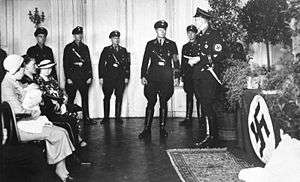European sexuality leading up to and during World War II
The years leading up to World War II (and during the conflict) saw great changes in the sexual habits of European societies.
France

In the occupation years as the French dealt with their humiliating defeat and surrender, the morality of sex in the Vichy occupation changed. In his book 1940–1945, The Erotic Years: Vichy, or, the Misfortunes of Virtue Patrick Buisson talks about “erotic shock ... or exploring new territories of pleasure."[1] After the occupation he writes about French prisoners bedding local German girls while back in their homeland French women had intimate relations with their German occupiers. Local cinemas and even subway stations became synonymous location for physical trysts during Allied bombings.[1] After Allied liberation any woman who had a reputation for associating with the Germans were targeted as collaborators and faced hazing or worse.
Germany
The German birth rate, like that in most industrial nations, had been falling for decades. When Hitler and the Nazi Party took power in 1933 they implemented several revolutionary policies in order to change the sexual practices of the German people and reverse this slide in birth rates. At the same time that it forbade the mixing of Jewish and German through the Nuremberg Laws, Nazi policy tried a number of policies designed to increase new births. One action was to change the marriage laws via the 1938 divorce-reform law by the Minister of Justice, Dr Gurtner.[2] Within two years 30,000 divorces were filed, 80% of which were husbands casting off women over 45 years old.[3] While the divorce law increased new marriages and children from these marriages, the Nazis looked to illegitimate births in Germany as a way to increase Germany's birthrate.[3]
In the 1920s there were about 150,000 illegitimate births in Germany, before halving during the depression and bouncing up to 100,000 in 1935.[3] The Nazis wanted to increase the illegitimate births by encouraging out of wedlock births, especially those of Aryan heritage. Part official policy, part propaganda, the Nazi policy manifested itself in the Lebensborn program. The Lebensborn program provided a place where pregnant mothers could have their babies out of wedlock in secret.[4]

Only the most "pure" of its applicants were chosen to join its programs. Of all the women who applied, only 40 percent passed the racial purity test (they had to show their family tree three generations back) and were granted admission to the Lebensborn program. The majority of mothers were unmarried, 57.6 percent until 1939, and about 70 percent by 1940.[5]
The Lebensborn program was given a further push when Himmler issued a proclamation that every SS soldier should father a child before he left for war. The child could then be born and raised at the Lebensborn facilities.[6] Through these policies the birth rate increased and Himmler told his doctor Kerstern how proud he was to have a role in the change, "Only a few years ago illegitimate children were considered a shameful matter ... [now] my men tell me with shining eyes that a son has been born to them. Their girls consider it an honour, not a source of shame."
Once World War II broke out and men were sent to the front, the Nazis changed their promise of "every woman will have a man" to "every woman will have a child". A report to the Ministry of Justice in 1944 stated that:
Leaders of the [German Girls' League have] intimated to their girls that they should bear illegitimate children; these leaders have pointed out that in view of the prevailing shortage of men, not every girl could expect to get a husband in future, and that the girls should at least fulfil their task as German women and donate a child to the Fuhrer.[7]
As a mark of how much sexual attitudes had changed by the end of the war, 23% of all young Germans were infected with a venereal disease, and prostitution had quadrupled.[8] Had the Germans triumphed, Himmler and Bormann were considering a post-war institution of double marriage for Nazi party officials and war heroes.[8]
See also
Bibliography
- Notes
- 1 2 frenchpubagency.com (2012). "1940–1945, The Erotic Years: Vichy, or, the Misfortunes of Virtue". frenchpubagency.com. Retrieved December 11, 2012.
- ↑ Grunberger 2005, p. 10
- 1 2 3 Grunberger 2005, p. 11
- ↑ Crossland 2006
- ↑ Jewish Virtual Library 2010
- ↑ Grunberger 2005, p. 13
- ↑ Grunberger 2005, p. 14
- 1 2 Grunberger 2005, p. 15
- References
- Crossland, David (November 6, 2006). "Himmler was my godfather". The Times. Retrieved December 9, 2010.
- Grunberger, Richard (2005). The Family. In A social history of the Third Reich (2005 ed.). Phoenix. ISBN 978-0-7538-1938-8. - Chapter page length: 17
- Jewish Virtual Library (2010). "The "Lebensborn" Program (1935-1945)". Jewish Virtual Library. Retrieved December 9, 2010.